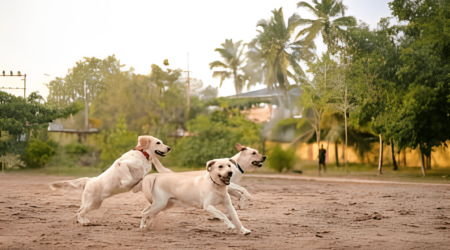Do American Staffordshire Terriers Have Webbed Feet? Helps & Guide
Welcome to our exploration of American Staffordshire Terriers (AmStaffs) and the intriguing world of canine anatomy. As dog lovers, understanding our furry friends’ physical features is essential. In this blog post, we’ll focus on a fascinating aspect – the paws of American Staffordshire Terriers. Specifically, we’ll address a common query: Do these lovable dogs have webbed feet?
Join us as we unravel the anatomy of AmStaffs, dispel myths, and discover whether the webbed feet characteristic is present in this breed. Get ready for an insightful journey into the unique traits that make AmStaffs the wonderful companions they are!

The Anatomy of American Staffordshire Terriers
General Physical Features:
- Brief overview of AmStaffs’ overall physique.
- Discussion on their muscular build and distinctive appearance.
- Highlighting key features that set them apart from other dog breeds.
Structure of Their Paws and Toes:
- Exploring the anatomy of AmStaffs’ paws and toes.
- Emphasizing the importance of paws in a dog’s daily activities.
- Addressing any unique characteristics in the paw structure of AmStaffs.
The Concept of Webbed Feet in Dogs:
- Defining and explaining the concept of webbed feet.
- Discussing the purpose of webbed feet in certain dog breeds.
- Setting the stage for the investigation into whether AmStaffs possess webbed feet.
Webbed Feet in Dogs
Explanation of Webbed Feet:
Webbed feet in dogs refer to the presence of skin between the toes, creating a paddle-like structure. This unique adaptation plays a crucial role in various activities, particularly those involving water. The webbing enhances a dog’s ability to swim efficiently and navigate aquatic environments. While not all breeds exhibit this trait, those with webbed feet showcase an evolutionary advantage, emphasizing the diverse adaptations that have evolved within the canine species.
Breeds Known for Having Webbed Feet:
Certain dog breeds are renowned for their distinctive webbed feet, showcasing the diversity of adaptations in the canine world. Examples include the Labrador Retriever, Newfoundland, and the Portuguese Water Dog. Each of these breeds has developed webbed feet to excel in specific roles, such as retrieving objects from water or aiding in water rescue missions. Understanding these breeds provides valuable insights into how webbed feet contribute to their unique skills and characteristics.
Functions and Advantages of Webbed Feet in Different Dog Breeds:
The functions of webbed feet extend beyond aesthetics, offering practical advantages for dogs in various settings. The primary benefit lies in improved swimming ability, allowing dogs to navigate water with efficiency and agility. This adaptation is particularly valuable for breeds involved in water-related activities, such as retrieving, hunting, or lifesaving operations. The versatility of webbed feet showcases the remarkable adaptability of certain dog breeds to their specific roles and environments.
Investigating American Staffordshire Terriers
Addressing Common Misconceptions:
There are often misconceptions surrounding AmStaffs, and one area of interest is their paw anatomy. Some may assume certain characteristics based on generalizations about dog breeds. We’ll sift through these misconceptions to uncover the truth about AmStaffs’ paws and whether webbed feet are a part of their unique features.
Examining the Paws of American Staffordshire Terriers:
A close examination of AmStaffs’ paws is essential to understand their anatomy accurately. We’ll explore the structure of their toes, nail placement, and any indications of webbing. By focusing on factual observations, we aim to provide a clear picture of the paw features that distinguish AmStaffs from other breeds.
Insights from Breed Standards and Expert Opinions:
Breed standards offer valuable guidelines for understanding the ideal characteristics of a particular breed. We’ll delve into the breed standards for American Staffordshire Terriers to see if webbed feet are mentioned or if there are other noteworthy aspects regarding their paws. Additionally, insights from experts in the field of dog anatomy and breeding can provide a well-rounded perspective on the topic.
Do American Staffordshire Terriers Have Webbed Feet?
Observations and Research Findings:
- Examine the paws of American Staffordshire Terriers through close observations.
- Look for any noticeable features that might suggest webbing between their toes.
- Conduct research on existing studies or documented observations related to AmStaffs’ paw structure.
Comparisons with Breeds Known for Webbed Feet:
- Identify and analyze breeds recognized for having webbed feet, such as the Labrador Retriever or Newfoundland.
- Highlight the distinctions in paw anatomy between breeds with and without webbed feet.
- Explore whether AmStaffs’ paw structure aligns with those known for webbed feet or exhibits unique characteristics.
Insights from Breed Standards:
- Refer to the breed standards for American Staffordshire Terriers to understand the ideal characteristics outlined for their paws.
- Look for any specific mentions of webbed feet or indications related to paw structure.
- Consider how breed standards may influence perceptions of AmStaffs’ paw anatomy.
Synthesis of Findings:
- Compile the observations, research findings, and insights from breed standards and experts.
- Evaluate whether there is consensus regarding the presence or absence of webbed feet in American Staffordshire Terriers.
- Present a well-rounded conclusion based on the collective evidence gathered throughout the investigation.
Practical Implications
Impact on Behavior and Abilities:
- Assess how webbed feet, if present, may influence AmStaffs’ behavior and abilities.
- Consider whether webbing enhances their swimming skills, agility, or performance in certain activities.
- Explore potential advantages or limitations in specific scenarios, such as water-based activities.
Considerations for AmStaff Owners:
- Provide insights for AmStaff owners regarding the unique features of their dogs’ paw anatomy.
- Discuss any special considerations or care practices related to webbed feet, if applicable.
- Offer guidance on activities that may align with the breed’s natural abilities, considering their paw structure.
Tips for Caring for Dogs with Webbed Feet:
- Share general tips for caring for dogs with webbed feet, drawing from experiences with breeds known for this characteristic.
- Emphasize the importance of regular paw maintenance, including nail trimming and checking for any signs of discomfort or injury.
- Provide guidance on introducing water-based activities safely, if relevant.
Also Read: American Staffordshire Terrier Shedding: Helps & Guide
In Short
Our exploration into whether American Staffordshire Terriers possess webbed feet has unraveled the intricate details of their unique anatomy. Through careful observations, comparisons with breeds known for webbed feet, and insights from breed standards and experts, we have gained a comprehensive understanding.
Whether or not AmStaffs have webbed feet, the practical implications for owners underscore the importance of tailored care and consideration for their natural abilities. This journey not only deepens our appreciation for the diverse traits within the canine world but also enhances our commitment to responsible ownership, ensuring the well-being and fulfillment of these remarkable companions.












Leave a Reply